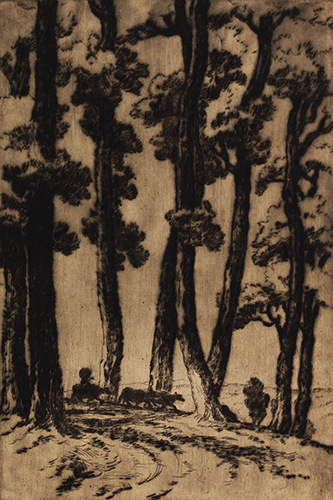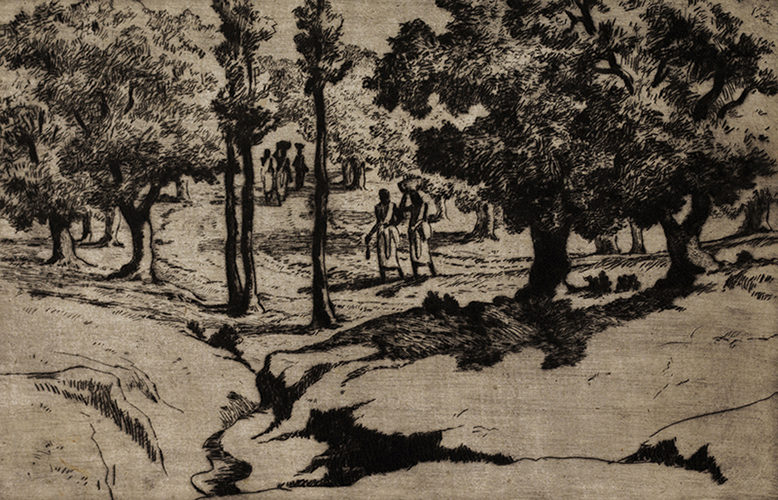Drypoint
By which medium Safiuddin Ahmed has skilfully composed images they are: wood-engraving, dry-point, etching, aquatint, metal-engraving, etc. Of these, except for the wood-engraving medium, the rest are of the Intelio method. In-house methods are used to make deep-shallow scratches on pens with diamonds or carborandum pieces, rubbing them with acid, varnishes, etc., and lowering the printing part below the level of the metal. By turning the ink on the metal made in this way and removing the ink from the non-scratched or non-acid-fed part, the impression is made on the wet paper with the pressure of a roller.
Dry points are a direct means. It is not possible to make a variety of lines, textures or textures and tones or colouring by etching aquatint etc. by covering it with stop-out and feeding it in acid. Through this, one has to draw a straight line on the metal plate and create a picture with its imprint. A special feature of the dry point medium is that when cutting the needle line of the needle or pin here its looks alike the plough blade lifts the soil on both sides and removes fine metal particles on both sides of the line. The lines on the paper take on a soft texture when imprinted with these fine metallic particles. It is not possible to take a large number of impressions of the metal through this, because the fine metal particles that have accumulated on both sides of the line gradually erode and thereby reduce the softness of the line in the imprint. For this reason, the dry point medium is quite difficult and laborious. If the hand slips or slips and the line do not move in the expected way, there is a risk that the picture will be ruined. As a result, the line has to be drawn through this with the help of very skilled hands.

Mukul Dey, Principal of Calcutta Art School, was a skilled artist of Dry Point. Safiuddin, a student of Mukul Dey’s Dry Point, was attracted to the medium because of its appeal to poetry. But there was no etching or dry point in the art school curriculum. The art school did not have the necessary machines for this. It was in Ramendranath Chakraborty’s private studio. Safiuddin Ahmed got the opportunity to work in the studio of that teacher in the period 1944-46.
The subject of Safiuddin Ahmed’s first painting through dry point is ‘Dumkar Shalban O Mosh’ (1944). In this picture, against the background of the length of the willow trees, the smallness of the buffaloes walking close to the ground has been shown. The appeal of the cosmos is the main one in this picture. The sky is covered with tree heights. This height further expands our vision as the tops of the trees are trimmed from the compositional format of the figure. In the cut-off method, parts of the forms disappear, creating an unseen expansion of the scene outside the frame. The feeling of how small and short we humans and other animals are to the vastness of nature is also evoked here. Safiuddin Ahmed’s philosophy of nature gained perfection in Dumka. Earlier he had gone to different parts of Bihar to practice nature; we find its identity in his watercolour. But it was in Dumka that he first felt the enormity of nature. The painting is successful in both subject matter and style. The appeal of the image is a lot like poetry. A kind of poetry is born in the way the two sides of the lines scratched by the hard needle in the metal take on a rough form. The use of light and shadow has also improved the image. The trunk of one tree has been specially blackened, while the others have been given more light.

In the picture ‘Dumka-1’ (1944) the subjects are seen from a higher place. The trees are not as tall as in the previous picture. The road is winding through the branches and dense deciduous trees. Two Santal women in the foreground and three more in the middle of the picture are carrying something on their heads. This image also excels in the use of light and shadow. In the same year, he completed two more Dumka-related paintings. Among these, ‘Dumka-2’ depicts the sky and the open desert of Dumka with mountains and small trees; And in ‘Mayurakshi’, the slender form of Mayurakshi flowing with a weak stream near the lap of the mountain. Working Santal women are crossing this river on foot.
The interior of a room of the Calcutta Art School was painted in the same medium in 1944. In the centre of this image is an easel, arranged in a white canvas. Other items in the room are illustrated with various craftsmanship of the line. The following year (1945) a model of the Calcutta Art School was depicted through dry points. This professional model has been associated with that school for a long time. The model with the beard and long hair wore a red hat. The feature of this portrait is that only the face is given importance instead of the full body. His facial expressions have gained special significance. This painting has been edited using very few lines.
An important image of this medium is the subject of ‘Two Santal Women Sitting on the Mayurakshi Shore’ (1945). The artist has painted an oil painting on the same subject, where the colour of the Gonja flowers on the Bangs of these two women is clear. These two figures are placed slightly curved in the middle of the image. These two women with empty pitchers have been captured from behind them. Their eyes are on the river. The left one of these two women is folding her left leg, keeping the left hand on the thigh; she is leaning back on the ground with her right hand. The surface of the body of both of them is almost open, covering with just a piece of clothes. This is their normal covering. In addition, two other women have got into the shallow stream of Mayurakshi with pitcher on their head; the water is not even equal to the knees. Due to the distance, their shape is as vague as it is short. Obscure hills in the background on the other side of the river. The two women sitting in this picture are dominant and everything is covered in gray. In this painting, the artist’s compositional skills are as perceptible as the artist’s position. The artist’s position is to the left behind the two women from where they can all be seen. This image captures a special moment, but it reveals a great and everlasting narrative of Santal women’s life.
The name of his latest painting is ‘Santiniketaner Drishyapot’ (1945). A sketch of him has been written under the same name on the same subject and scene. Safiuddin Ahmed along with his teammate Satyen Ghoshal went to Santiniketan in 1945. For the purpose of meeting artist Nandalal Bose, artist Binod Bihari Mukherjee and others with the letter of Ramendranath Chakraborty, teacher of Calcutta Government Art School. The diagram was drawn at that time; Later on this basis he drew this picture back to Calcutta at dry point. Rows of long palm trees cut through the rough soil of Birbhum, through which the way of life of the Santal people is carried by ox carts or on foot. The painting has been successful in the use of light and shadow and the subtlety of the perspective. Compared to the talsari of the foreground, the talsari of the distant background is gray in obscurity. The whole scene is illuminated as it is not painted against the light. The palm trees are dull in their natural color. The two trees closest to the foreground are the most obvious, but the top of the tree could not be part of the whole picture because of the proximity. This has been done consciously to clarify the near-far perspective. It is also a testament to the artist’s creative ability. It feels as if these two nearby trees are taking the picture away. The path is slightly curved upwards. From the point of view of lines, some lines are of horizontal or curved type, some are of vertical nature. The first has been instrumental in creating the roadmap and the second in drawing the tree. The combination of the calmness between the horizontal line and the vertical line is significant.
Art historian and Art critic Professor Syed Azizul Huq, Chairman, Bangla Department, University of Dhaka
Translated by: Noshin Shamma and Priyanka Chowdhury
Edited by: Priyanka Chowdhury